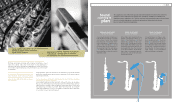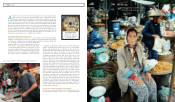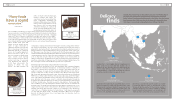Sennheiser 2010 Annual Report Download - page 18
Download and view the complete annual report
Please find page 18 of the 2010 Sennheiser annual report below. You can navigate through the pages in the report by either clicking on the pages listed below, or by using the keyword search tool below to find specific information within the annual report.
01 The right amount
of moisture, the ideal
thickness: just two of the
many sound components
of cookies.
02 The analog camera as
role model: The shutter
sound of today’s digital
cameras is often
electronically intensified.
03 Sound designers also
tinker around with
wristwatches, which
should never sound like
a kitchen timer.
04 As expensive on
the outside as it is on
the inside. Designing a
perfume bottle is
just as much a labor of
love as formulating
the perfume that fills it.
It’s like a scene from a children’s storybook. The grandmother stretches out her arms, giving her
grandson a whiff of the promise of a batch of cookies hidden within the rustling baking
parchment lining the colorful cookie tin she is holding. The slightly hollow thump of the cookie
tin being opened is something he will never forget. Nor is the sweet smell of the cookies, their
crumbly texture nor their heavenly taste. We carry these types of experiences with us for the rest
of our lives. Just a sound or a scent can trigger a memory of how a fabric feels. But our senses don’t
just trigger memories. They are also quick to register a pleasant association that affects the here
and now. Whether it’s a cookie jar or a luxury sedan, manufacturers have long known that there
is more to brand positioning than functionality and visual appeal. To distinguish themselves from
the competition, brand-name products have to smell, taste and feel good if they are going to res-
onate with customers. Multisensory product design doesn’t just address the external characteris-
tics of an object. It also manipulates deeper underlying perceptions and transmits subliminal mes-
sages that trigger the emotions.
The customer wants a sensory experience that reflects the type of car he drives.
Hendrik N.J. Schifferstein and Paul Hekkert are researchers at the Delft University of Technology
in the Netherlands. The two young professors collaborated on the book Product Experience.
Says Schifferstein, “Even though the interaction between the consumer and product clearly
depends on the product, an emotional aspect also exists.” Schifferstein defines product
experience as a complex structure founded on sensory and motor perception, experience, and
emotion. One of the researchers’ findings is that consumers are enticed into buying a product
before they have actually laid hands on it – simply by their perception of a sensory experience. A
television commercial that shows someone biting into a cookie, which is then followed by a loud
crunch, conveys the message that a
crunch means crispiness. In the end, the
sound should reveal something to the
customer. Anyone who buys a choco-
late ice cream bar anticipates that first
delicate cracking of the chocolate shell.
Advertising has gone to great lengths
to communicate this sound so that,
when we do hear it, our mouths begin
to water. Someone looking to buy a car
may imagine the smell of its leather
interior or the sound of the engine. This
is why Mercedes-Benz set up its own
acoustic laboratory at the end of the
1990s. The lab’s first task was to make
34 PRODUCT EXPERIENCE
the car quieter. However, as they quickly realized, the melody of a car is more than
just its exhaust and engine; it is the combination of these sounds that influences
brand perception. For instance, the sound of a Mercedes-Benz CLS at a constant
speed should be unobtrusive: when accelerating, it should be powerful. A third of
all automobile buyers reported being able to identify the make of a car by the
sound of the door being shut. At Porsche, dozens of engineers work together in a
sound studio to find the perfect brand-specific sound. It is estimated that the
Swabians spend more than €20 million to design the sound of each and every new
model. By the time an automobile manufacturer branches out into researching all
the other senses, the team may have grown to more than 100 engineers, chemists,
physicists, and neuropsychologists. No one argues that sight is the fastest way to
assimilate the bulk of information. It also has the greatest impact on previous
experience. Even so, marketing studies have shown that adding other senses more
than triples product association. Touch and smell were identified as being the
“most emotional” senses. While Audi’s “nose team” works on keeping the smell as
neutral as possible, other manufacturers come up with a signature scent.
An extremely quiet vacuum cleaner is generally regarded as having no oomph.
Just like smell, the sense of hearing has the ability to access ancient,
evolutionary areas of the brain. Professor Eckart Altenmüller, a neurologist and
musician at the University of Music, Drama and Media Hanover, confirms this
direct link to the Stone Age. “It takes 300 milliseconds for a person to identify
the emotion in the speech of his dialog partner, and only 100 milliseconds to rec-
ognize whether the tone of a violin is happy, sad or angry.“ Multisensory design-
01
03
02
04
35
PRODUC T EXPERIENCE
























